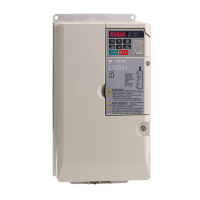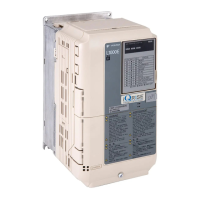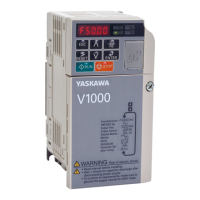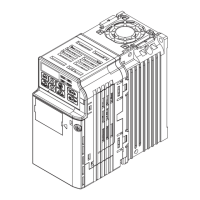8 Troubleshooting
YASKAWA Europe TOEP C710616 92D AC Drive L1000H Quick Start Guide EN 39
Overcurrent
(oC)
• Short-circuit or ground fault on the drive output side.
• The drive is damaged.
• The load is too heavy.
• The acceleration or deceleration ramps are too short.
• The overcurrent level has exceeded the value set to
L8-27. (PM control modes)
• Incorrect motor data or V/f pattern settings.
• The motor contactor was switched while the drive was
running.
• Check the output wiring and the motor for short
circuits or broken insulation. Replace the broken
parts.
• Check the machine for damages (gears, etc.) and
repair any broken parts.
• Check the drive output side short circuit for broken
output transistor.
B1 and U/V/W
– (negative) and U/V/W
Contact your YASKAWA representative or nearest
YASKAWA sales office.
• Make sure the brake fully opens.
• Check accel/decel settings in C1- and C2-.
• Correct the value set to overcurrent detection gain
(L8-27).
• Check V/f pattern settings in E1- (E3- for
motor 2).
• Check the output contactor sequence.
Heatsink Overheat
(oH) or (oH1)
• Surrounding temperature is too high.
• The cooling fan has stopped.
• The heatsink is dirty.
• The airflow to the heatsink is restricted.
• Check the surrounding temperature and install
cooling devices if necessary.
• Check the drive cooling fan.
• Clean the heatsink.
• Check the airflow around the heatsink.
Motor Overload
(oL1)
• The motor load is too heavy.
• Acceleration and deceleration cycle times are too
short.
• Value set for the motor rated current is incorrect.
• Check the elevator mechanics.
• Check the sequence.
• Check the rated current setting.
Drive Overload
(oL2)
• The load is too heavy.
• The drive is too small.
• Too much torque at low speed.
• Check the load.
• Make sure that the drive is big enough to handle the
load.
• The overload capability is reduced at low speeds.
Reduce the load or increase the drive size.
DC Bus
Overvoltage
(ov)
• DC bus voltage rose too high.
• Braking transistor is too small.
• Braking chopper or resistor is broken.
• Unstable motor control in OLV.
• Input voltage is too high.
• Make sure the braking resistor and braking chopper
are working correctly.
• Check motor parameter settings and adjust torque and
slip compensation as needed.
• Make sure that the power supply voltage meets the
drives specifications.
Input Phase Loss
(PF)
• Input voltage drop or phase imbalance.
• One of the input phases is lost.
• Drive input wire are loose.
• Check the motor wiring.
• Make sure all terminal screws in the drive and motor
are properly tightened.
• Check the motor and drive capacity.
Braking Resistor
Fault
(rF)
• The proper braking resistor option has not been
installed.
• Regenerative converter, regenerative unit, or braking
unit is being used.
• Select the braking resistor option so that fits to the
drives braking transistor specification.
• Disable the braking transistor protection selection (set
L8-55 to 1).
Internal Braking
Transistor Fault
(rr)
The internal braking transistor is defective or the
braking resistor is connected wrong.
• Make sure the braking resistor is connected correctly.
• Cycle the power supply.
• Replace the drive if the fault reoccurs.
IGBT Short
Circuit
(SC)
• The motor has been damaged due to overheating or
the motor insulation is damaged.
• One of the motor cables has shorted out or there is a
grounding problem.
• The drive is damaged.
• Check the insulation resistance.
• Check the wiring to the motor. Turn the power supply
off and then on again to check operation.
• Check the drive output side short circuit for broken
output transistor.
B1 and U/V/W
– (negative) and U/V/W
Contact your YASKAWA representative or nearest
YASKAWA sales office.
Safety Circuit
Fault
(SCF)
The safety circuit is damaged.
If the problem continues, replace the control board or
the entire drive. Contact YASKAWA or a YASKAWA
representative for instructions on replacing the control
board.
Digital Operator AL FLT Possible Cause Corrective Action

